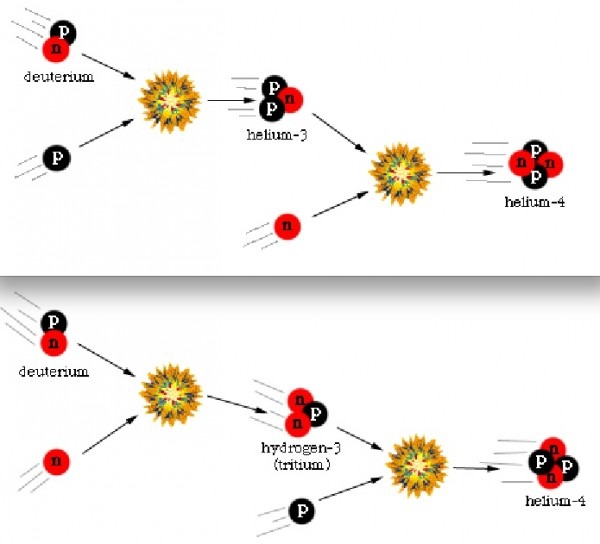Helium 4
Helium is a chemical element symbolized by (He) in the periodic table of elements at the top right corner with atomic no. 2. It is derived from the Greek word “Helios,” which means the Sun. Nuclear fusion in stars like the sun produces large volumes of helium from hydrogen. It also holds the second rank in being the lightest and the most abundant element in the observable universe (around 24% of the total elemental mass of the universe). Due to very high nuclear binding energy per nucleon, and therefore, being inert (non- reactive) in nature, it is present in such large volumes around the universe.
In general, it is present in the gaseous form, but it can be liquefied under very high pressure (around 25 atm) and very low temperature (around -269°C).
Helium near absolute zero
Properties of Helium
- Detailed decay information for the isotope helium-4 including decay chains and daughter products.
- The Helium 4 is the most advanced kite in our range. High-performance foilborders, surfers, travelers, and freeriders that want to get out in lighter wind conditions or who want a light and responsive kite will find the new Helium exceeding their expectations.
- Helium-3 3He and helium-4 4He are two isotopes of helium that appear in the Fleischmann's hypothesis and they have been targets of eager investigation from the beginning. Unfortunately, they have a peculiar property to escape easily through glass, which we usually use in experiments.
Grade 4 (4.0 helium and lower = 99.99% purity) Any helium that is 99.99% and down into the high 80 percents is within the range of purities referred to collectively as “ balloon grade helium.”.
Helium is a colorless, odorless, tasteless, inert, and non-toxic noble gas.
Physical Properties
At normal atmospheric pressure, solid helium does not exist, hence, it does not account for any melting point, but it has been found that once we raise the pressure to 25 atm, it starts melting around -272.2 °C.
Because of being monatomic in nature and having weak interatomic interactions, Helium’s boiling point is also known to be very low (-269 °C), and that’s why it exists in the gaseous state mostly. At the atmospheric pressure of 1 atm and 0°C, it’s density is found to be 0.000164 g cm−3. The only known gas to have a density less than this is Hydrogen.
Chemical Properties
Chemical properties of any element are observed when it interacts with its surroundings and takes part in various chemical reactions. Being inert in nature, Helium doesn’t take part in many chemical reactions.
The electronic configuration of Helium is 1s2. It is widely known as the least soluble gas in water and has a refractive index closer to one. The helium that is found outside the atmosphere of the earth exists in the plasma state and due to the presence of free electrons in the plasma state, it results in very high electric conductivity.
Highly conductive helium in a discharge tube
Isotopes

Helium is known to have nine isotopes, out of which only 3-Helium and 4-Helium are stable, all other isotopes are highly radioactive, and therefore, they do not stay for long. The abundance in the earth’s atmosphere of 3-helium and 4-helium is 0.0002% and 99.9998%, respectively.

Occurrence and Production
Most of the helium present in the universe is generated from nucleosynthesis (the process of creating new atomic-nuclei from the pre-existing ones) that happened during the Big Bang.
Luxion keyshot for mac torrent. But the helium present in the earth’s atmosphere comes from the alpha decay of radioactive nuclei.
For industry-centric purposes, helium is extracted by a process of fractional distillation in which the natural gas is distilled under high pressure and low temperature. Due to its low boiling point, other gases from natural gas gets liquified prior, and helium can be isolated.
Helium storage in a natural gas processing plant
Uses of Helium
Being non-reactive in nature, helium can be used in a variety of applications. For the most common example, we all have seen helium balloons being used as an energy-efficient mode of flight during the early 19th century, but that is a very minor application of helium. Nowadays, helium is one of the major ingredients of most of the technological, medical, and industrial advancements. Some of them are discussed below.
1. Industrial Application
Because of its inert nature, helium acts as a shield when it comes to reducing the reactivity of the system with its surrounding. In the arc welding process, helium acts as a barrier between nitrogen and metal, so that it does not pollute the welding.
It can also be used for leak detection in various industries as helium has a very high diffusion rate and does not react much with the atmosphere.
An engineer checking for leaks in a depressurized pipe
Helium-4 Neutrons
2. Medical Application
Due to its cryogenic properties, helium is widely used in heavy machinery like MRI machines, CT-SCANS, and NMR spectroscopy to protect machines from overheating. Many of these machines are used in the detection of major tumors and cancers.
Some people also use helium balloons for recreational purposes, though it does not have any narcotic properties. People inhale helium from party balloons to make there voice high-pitched as helium is less dense than air and allows sound to travel faster. But it can be a harmful practice as the uncontrolled amount of helium can be fatal.
Helium is also known to be a necessary ingredient when it comes to deep-sea diving. Due to a lower gas density of helium, it helps to flush out nitrogen and even oxygen, which can have drastic effects below 60-70 ft of water.

Helium 4
3. Technological Application
Helium 4 On The Moon
Helium has a very low boiling point, so it is used as a coolant in many technological wonders. Liquid helium is used in the LHC particle accelerator at CERN to cool down the superconducting magnetic coils.
Liquid helium providing near absolute zero temp. at LHC to keep Magnetic coils cool
Helium 4 Isotope

Also, it is used between the lenses of a telescope to reduce the heating effect caused by light. It is widely used as a gas carrier in gas chromatography. Helium also helps in space missions by keeping the rocket fuel cool during the launch. It is also used as a coolant in nuclear reactors.
Critical Element
Helium 4f2
Helium is so lightly dense that if once it is released into the atmosphere it will rise in the upward direction and try to escape the atmosphere, due to which it is hard for scientists to recover it. Prices of helium have already been skyrocketed due to increased demand and low supply. Humankind can look for alternatives and make technological advancements so that helium can be replaced by hydrogen.
